Oracle 1z0-061 Exam Practice Questions (P. 1)
- Full Access (339 questions)
- One Year of Premium Access
- Access to one million comments
- Seamless ChatGPT Integration
- Ability to download PDF files
- Anki Flashcard files for revision
- No Captcha & No AdSense
- Advanced Exam Configuration
Question #1
Evaluate the following SQL statement:
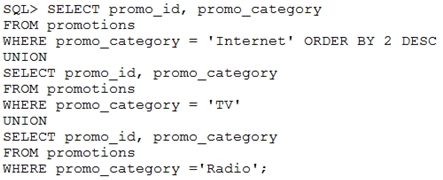
Which statement is true regarding the outcome of the above query?

Which statement is true regarding the outcome of the above query?
- AIt executes successfully and displays rows in the descending order of PROMO_CATEGORY.
- BIt produces an error because positional notation cannot be used in the order by clause with set operators.
- CIt executes successfully but ignores the order by clause because it is not located at the end of the compound statement.
- DIt produces an error because the order by clause should appear only at the end of a compound query-that is, with the last select statement.
Correct Answer:
D
D
send
light_mode
delete
Question #2
View the Exhibit and examine the structure of the product, component, and PDT_COMP tables.
In product table, PDTNO is the primary key.
In component table, COMPNO is the primary key.
In PDT_COMP table, <PDTNO, COMPNO) is the primary key, PDTNO is the foreign key referencing PDTNO in product table and COMPNO is the foreign key referencing the COMPNO in component table.
You want to generate a report listing the product names and their corresponding component names, if the component names and product names exist.
Evaluate the following query:
SQL>SELECT pdtno, pdtname, compno, compname
FROM product _____________ pdt_comp
USING (pdtno) ____________ component USING (compno)
WHERE compname IS NOT NULL;
Which combination of joins used in the blanks in the above query gives the correct output?
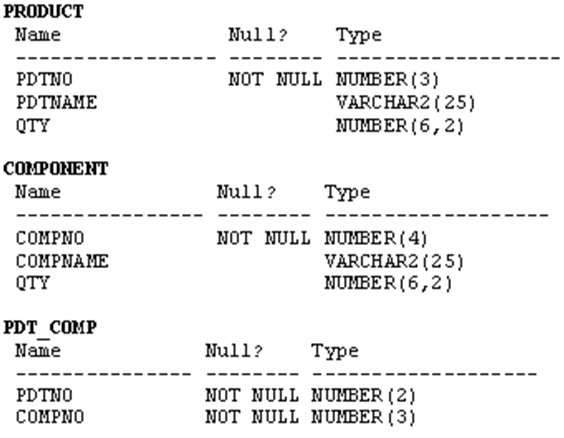
In product table, PDTNO is the primary key.
In component table, COMPNO is the primary key.
In PDT_COMP table, <PDTNO, COMPNO) is the primary key, PDTNO is the foreign key referencing PDTNO in product table and COMPNO is the foreign key referencing the COMPNO in component table.
You want to generate a report listing the product names and their corresponding component names, if the component names and product names exist.
Evaluate the following query:
SQL>SELECT pdtno, pdtname, compno, compname
FROM product _____________ pdt_comp
USING (pdtno) ____________ component USING (compno)
WHERE compname IS NOT NULL;
Which combination of joins used in the blanks in the above query gives the correct output?

- AJOIN; JOIN
- BFULL OUTER JOIN; FULL OUTER JOIN
- CRIGHT OUTER JOIN; LEFT OUTER JOIN
- DLEFT OUTER JOIN; RIGHT OUTER JOIN
Correct Answer:
C
C
send
light_mode
delete
Question #3
View the Exhibit for the structure of the student and faculty tables.
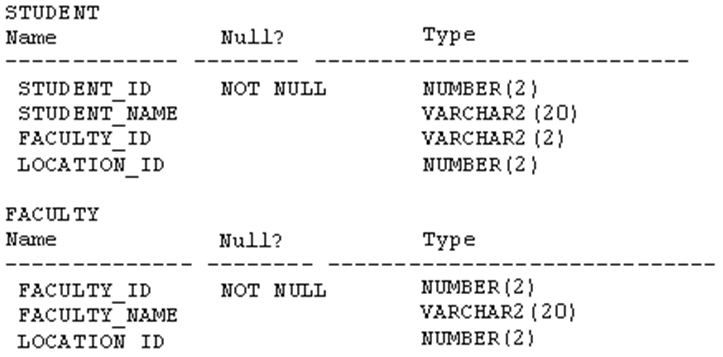
You need to display the faculty name followed by the number of students handled by the faculty at the base location.
Examine the following two SQL statements:
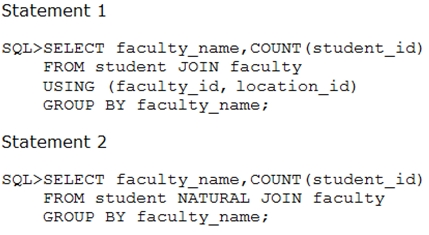
Which statement is true regarding the outcome?

You need to display the faculty name followed by the number of students handled by the faculty at the base location.
Examine the following two SQL statements:

Which statement is true regarding the outcome?
- AOnly statement 1 executes successfully and gives the required result.
- BOnly statement 2 executes successfully and gives the required result.
- CBoth statements 1 and 2 execute successfully and give different results.
- DBoth statements 1 and 2 execute successfully and give the same required result.
Correct Answer:
D
D
send
light_mode
delete
Question #4
View the Exhibits and examine products and sales tables.
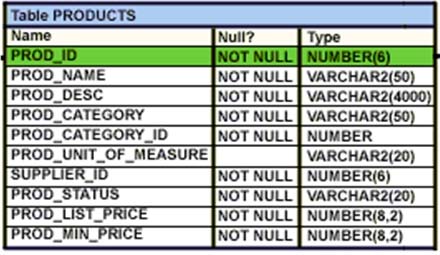
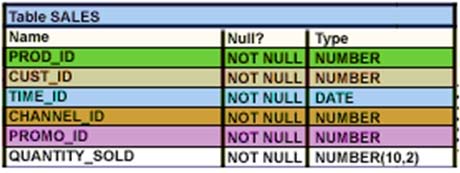
You issue the following query to display product name and the number of times the product has been sold:

What happens when the above statement is executed?


You issue the following query to display product name and the number of times the product has been sold:

What happens when the above statement is executed?
- AThe statement executes successfully and produces the required output.
- BThe statement produces an error because item_cnt cannot be displayed in the outer query.
- CThe statement produces an error because a subquery in the from clause and outer-joins cannot be used together.
- DThe statement produces an error because the group by clause cannot be used in a subquery in the from clause.
Correct Answer:
A
A
send
light_mode
delete
Question #5
You want to create a table employees in which the values of columns EMPLOYEES_ID and LOGIN_ID must be unique and not null. Which two SQL statements would create the required table?
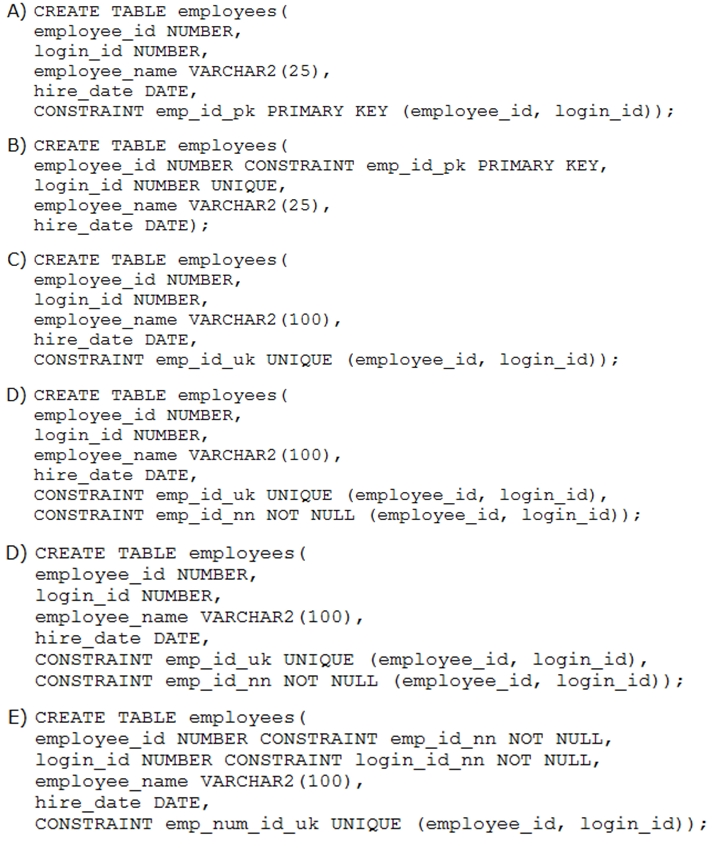

send
light_mode
delete
Question #6
View the Exhibit and examine the structure of the products table.
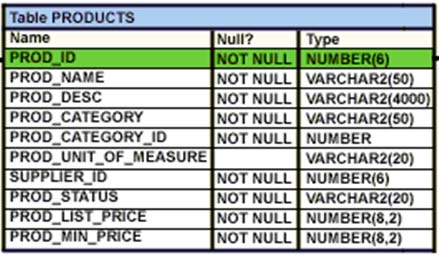
Using the products table, you issue the following query to generate the names, current list price, and discounted list price for all those products whose list price falls below $10 after a discount of 25% is applied on it.

The query generates an error. What is the reason for the error?

Using the products table, you issue the following query to generate the names, current list price, and discounted list price for all those products whose list price falls below $10 after a discount of 25% is applied on it.

The query generates an error. What is the reason for the error?
- AThe parenthesis should be added to enclose the entire expression.
- BThe double quotation marks should be removed from the column alias.
- CThe column alias should be replaced with the expression in the where clause.
- DThe column alias should be put in uppercase and enclosed within double quotation marks in the where clause.
Correct Answer:
C
C
send
light_mode
delete
Question #7
Examine the structure proposed for the transactions table:
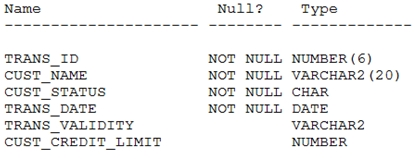
Which two statements are true regarding the creation and storage of data in the above table structure?

Which two statements are true regarding the creation and storage of data in the above table structure?
- AThe CUST_STATUS column would give an error.
- BThe TRANS_VALIDITY column would give an error.
- CThe CUST_STATUS column would store exactly one character.
- DThe CUST_CREDIT_LIMIT column would not be able to store decimal values.
- EThe TRANS_VALIDITY column would have a maximum size of one character.
- FThe TRANS_DATE column would be able to store day, month, century, year, hour, minutes, seconds, and fractions of seconds
Correct Answer:
BC
VARCHAR2(size)Variable-length character data (A maximum size must be specified: minimum size is 1; maximum size is 4, 000.)
CHAR [(size)] Fixed-length character data of length size bytes (Default and minimum size is 1; maximum size is 2, 000.)
NUMBER [(p, s)] Number having precision p and scale s (Precision is the total number of decimal digits and scale is the number of digits to the right of the decimal point; precision can range from 1 to 38, and scale can range from 84 to 127.)
DATE Date and time values to the nearest second between January 1, 4712 B.C., and December 31, 9999 A.D.
BC
VARCHAR2(size)Variable-length character data (A maximum size must be specified: minimum size is 1; maximum size is 4, 000.)
CHAR [(size)] Fixed-length character data of length size bytes (Default and minimum size is 1; maximum size is 2, 000.)
NUMBER [(p, s)] Number having precision p and scale s (Precision is the total number of decimal digits and scale is the number of digits to the right of the decimal point; precision can range from 1 to 38, and scale can range from 84 to 127.)
DATE Date and time values to the nearest second between January 1, 4712 B.C., and December 31, 9999 A.D.
send
light_mode
delete
Question #8
You need to create a table for a banking application. One of the columns in the table has the following requirements:
1) You want a column in the table to store the duration of the credit period.
2) The data in the column should be stored in a format such that it can be easily added and subtracted with date data type without using conversion functions.
3) The maximum period of the credit provision in the application is 30 days.
4) The interest has to be calculated for the number of days an individual has taken a credit for.
Which data type would you use for such a column in the table?
1) You want a column in the table to store the duration of the credit period.
2) The data in the column should be stored in a format such that it can be easily added and subtracted with date data type without using conversion functions.
3) The maximum period of the credit provision in the application is 30 days.
4) The interest has to be calculated for the number of days an individual has taken a credit for.
Which data type would you use for such a column in the table?
- ADATE
- BNUMBER
- CTIMESTAMP
- DINTERVAL DAY TO SECOND
- EINTERVAL YEAR TO MONTH
Correct Answer:
D
INTERVAL DAY TO SECOND stores a period of time in terms of days, hours, minutes, and seconds. This data type is useful for representing the precise difference between two datetime values.
You can perform a number of arithmetic operations on date (DATE), timestamp (TIMESTAMP, TIMESTAMP WITH TIME ZONE, and TIMESTAMP WITH LOCAL
TIME ZONE) and interval (INTERVAL DAY TO SECOND and INTERVAL YEAR TO MONTH) data.
It stores duration of the credit as days
The format stored is numeric format, and you know that numeric values can be easily added and subtracted with date data type without using conversion functions (i.e. SELECT SYSDATE 1 FROM DUAL;)
The interest has to be calculated for the number of days an individual has taken a credit for, so it will be easy to calculate interest by using the interest rate and duration of the the credit which is numeric format.
Reference:
https://docs.oracle.com/cd/B19306_01/server.102/b14225/ch4datetime.htm
D
INTERVAL DAY TO SECOND stores a period of time in terms of days, hours, minutes, and seconds. This data type is useful for representing the precise difference between two datetime values.
You can perform a number of arithmetic operations on date (DATE), timestamp (TIMESTAMP, TIMESTAMP WITH TIME ZONE, and TIMESTAMP WITH LOCAL
TIME ZONE) and interval (INTERVAL DAY TO SECOND and INTERVAL YEAR TO MONTH) data.
It stores duration of the credit as days
The format stored is numeric format, and you know that numeric values can be easily added and subtracted with date data type without using conversion functions (i.e. SELECT SYSDATE 1 FROM DUAL;)
The interest has to be calculated for the number of days an individual has taken a credit for, so it will be easy to calculate interest by using the interest rate and duration of the the credit which is numeric format.
Reference:
https://docs.oracle.com/cd/B19306_01/server.102/b14225/ch4datetime.htm
send
light_mode
delete
Question #9
Which three tasks can be performed using SQL functions built into Oracle Database?
- ADisplaying a date in a nondefault format
- BFinding the number of characters in an expression
- CSubstituting a character string in a text expression with a specified string
- DCombining more than two columns or expressions into a single column in the output
Correct Answer:
ABC
ABC
send
light_mode
delete
Question #10
View the Exhibit and examine the description of SALES and PROMOTIONS tables.
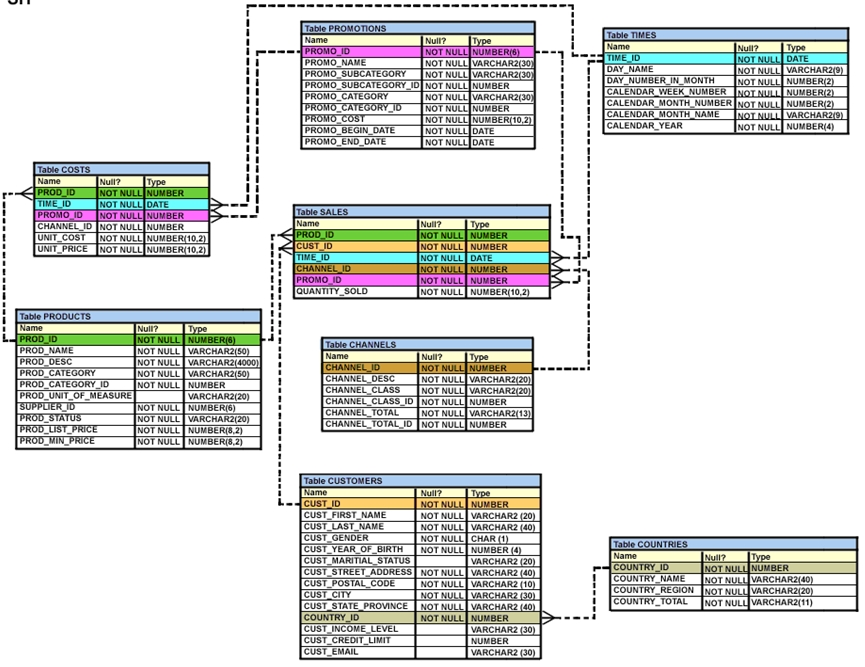
You want to delete rows from the sales table, where the PROMO_NAME column in the promotions table has either blowout sale of everyday low prices as values.
Which three delete statements are valid?
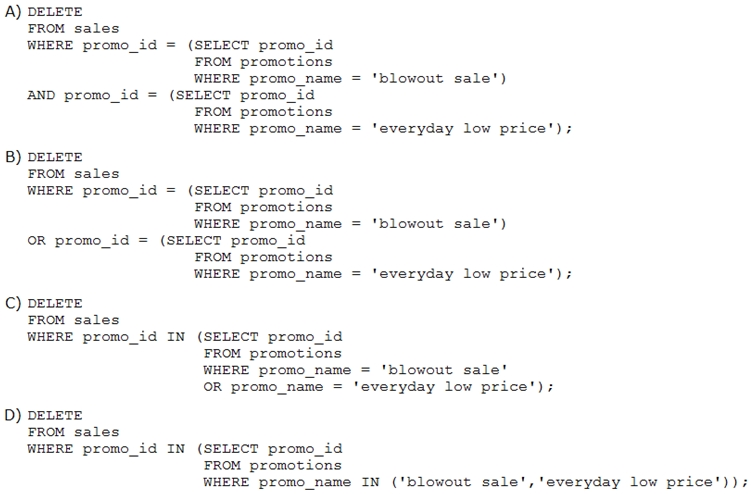

You want to delete rows from the sales table, where the PROMO_NAME column in the promotions table has either blowout sale of everyday low prices as values.
Which three delete statements are valid?

send
light_mode
delete
All Pages
